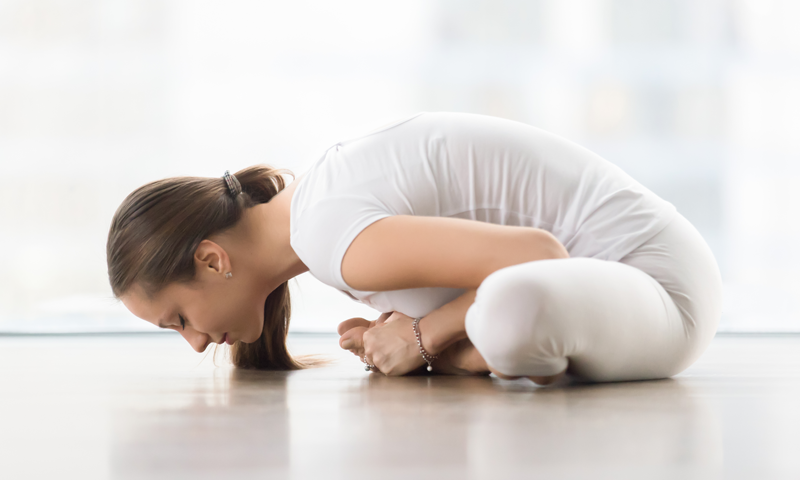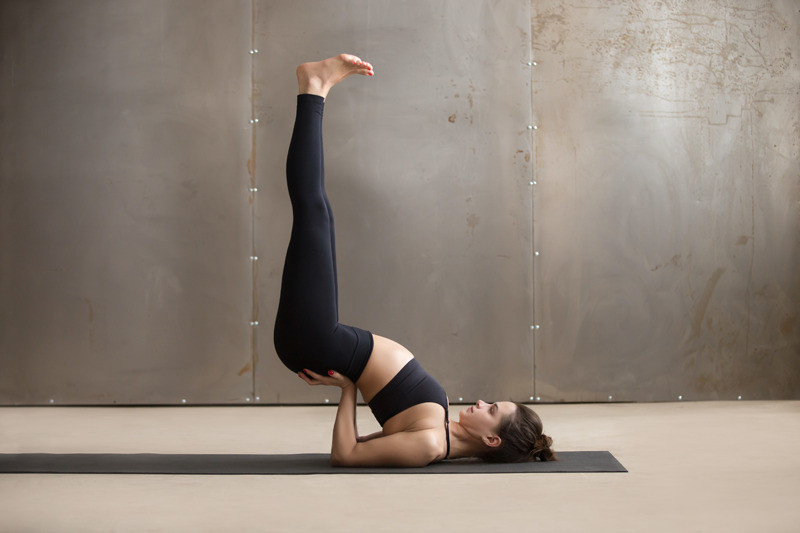
Yoga Poses to Relieve Cramps
15th November 2018
Yoga Poses for People Who Sit All Day
22nd November 2018Yoga Poses for Intermediate Learners

Once you’ve been practising yoga for a while, standard classes may feel a little easy. While some yogis are happy with this, others prefer to take their practice to the next level. If expert classes are too challenging, it can be difficult to find that happy medium. Thankfully, we’re here to help. In this article, we explore some of the most popular yoga poses for intermediate learners. All you need to begin is a comfortable mat and a breathable yoga vest.
Boat Pose
Strengthening the abdominal muscles and hips, Boat Pose is popular amongst intermediate learners. To practice the asana, start by sitting on your mat with your legs out in front of you. Next, place your hands just behind your hips with your fingertips pointing towards your feet. Press your palms firmly into the ground as you straighten your arms. Keeping your back straight, gently lean back and lift your feet off the ground. Your shins should now be parallel to the floor. Lengthen the front of your torso and puff out your chest. Finally, extend both arms forward until they are in line with your shoulders. You are in Boat Pose. Hold the asana for 30 seconds whilst breathing deeply. For best results, draw your chin into your chest throughout the posture. This action provides a deeper stretch by bringing the base of your skull away from the neck.
Half Frog Pose
Half Frog Pose stretches the front of your shins, your ankles, and also your quadriceps. To practice the asana, start by lying flat on your stomach. Next, bend your elbows and prop yourself up on your forearms. At this stage, your forearms should be parallel to one another. Turn your left arm until your fingertips point towards the top left corner of your mat. Bend your left knee and reach your left arm back to take hold of your left foot. To deepen the stretch, gently pull your foot into your bottom. You are in Half Frog Pose. Hold the asana for 30 seconds before repeating on the other side.
Half Tiger Pose
Half Tiger is another intermediate asana. Stretching the calves and feet, this posture is great for relieving tension after a long day on your feet. To practice the asana, begin in Plank Position. Before moving onto the next stage, ensure that your shoulders sit above your wrists and your hips are aligned with your shoulders. To create stability, spread your fingers apart and press your palms into the ground. Engaging your abdominal muscles, lift your right foot off the mat and bring your knee into your chest. Firming your quadriceps for support, lift your stomach up and drop your left heel towards the mat. You are in Half Tiger Pose. Hold the asana for around 1 minute before switching sides.
Camel Pose
Increasing blood flow to the brain, Camel Pose can prevent the onset of headaches. To practice the asana, kneel on your mat with your knees below your hips. Next, place your hands on your bottom with your fingers pointing down. As you inhale, move your pelvis forward and lean your head and torso back. At this stage, you should feel the stretch in your upper thighs. Next, reach your left hand back and hold the heel of your left foot. If your body allows it, do the same on the right side. If your flexibility is limited, however, stick to just one side. Finally, move your pelvis forward and round your spine. You are in Camel Pose. Hold the posture for 30 seconds whilst breathing deeply. During the asana, it’s important not to strain the neck. If you start to feel pain, adjust your form accordingly. If the discomfort persists, exit the pose and move onto the next.

Supported Headstand
Another great pose for intermediate learners, Supported Headstand encourages blood flow to the brain. Over time, it can revitalise the brain cells and promote clear thinking. To practice the asana, kneel on your mat and sit back on the heels of your feet. Leaning forward, rest your forearms on the ground and interlock your fingers. Next, place the top of your head flat on the mat whilst pressing the back of your head against your arms. Finally, slowly lift your legs off the floor and extend them fully. You are in Supported Headstand. Hold the asana for 30 seconds whilst concentrating on your breathing. If you’re struggling to stay balanced, practice the asana against a wall for support.
Four-Limbed Staff Pose
To practice Four-Limbed Staff Pose, begin by lying on your stomach. Next, place your hands underneath your shoulders and curl your toes under. As you inhale, extend your arms to lift your body off the mat. From this position, move your body forward so your shoulders are aligned with your fingertips. As you exhale, slowly bend your elbows; as you inhale, slowly straighten them. You are in Four-Limbed Staff Pose. Repeat the sequence 5 times before lowering yourself back down to the mat.
Locust Pose
The final pose in the intermediate sequence is Locust Pose. To practice the asana, start by lying flat on your stomach. Keeping the tops of your feet on the mat, move your feet apart until they are aligned with your hips. Your arms should rest by the sides of your body with your palms touching the mat. Next, take a deep breath in and lift your chest away from the mat. Hold the position for 5 seconds before lowering yourself back down. You are in Locust Pose. Repeat this process 5 times whilst breathing deeply.
In Summary
If your regular yoga class isn’t challenging you enough, practice yoga poses for intermediate learners to improve your craft. The great thing about the postures above is that they can be practised independently. As the sequence can be practised from home, all you need is a quiet space and a supportive yoga bra.

